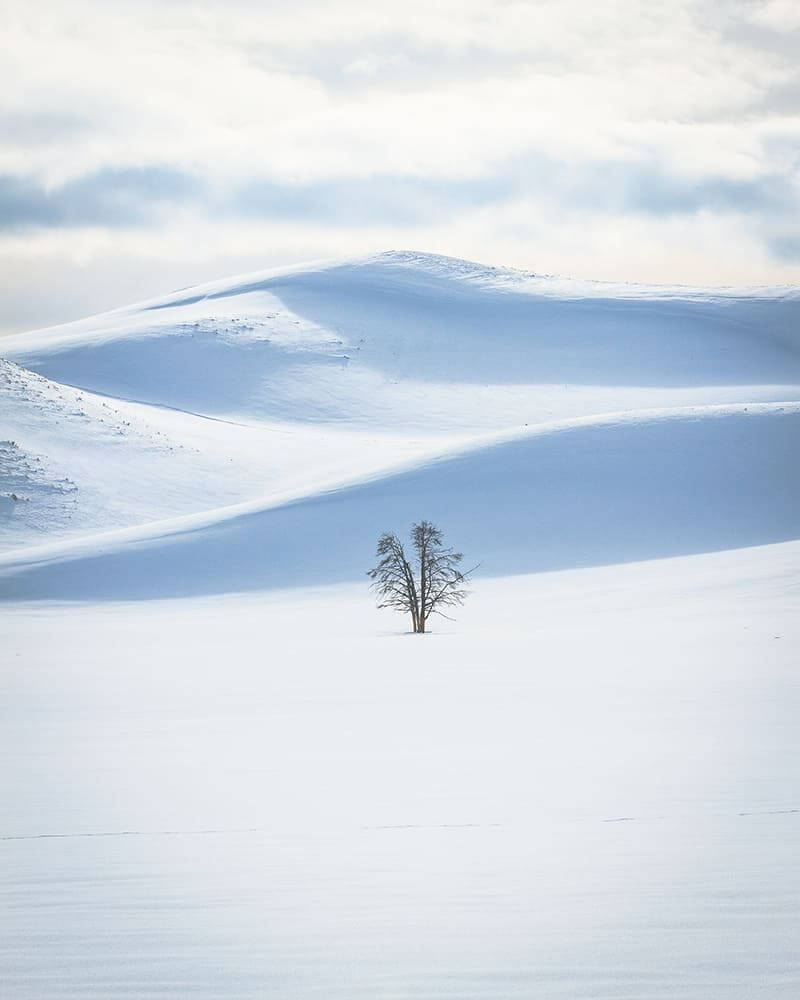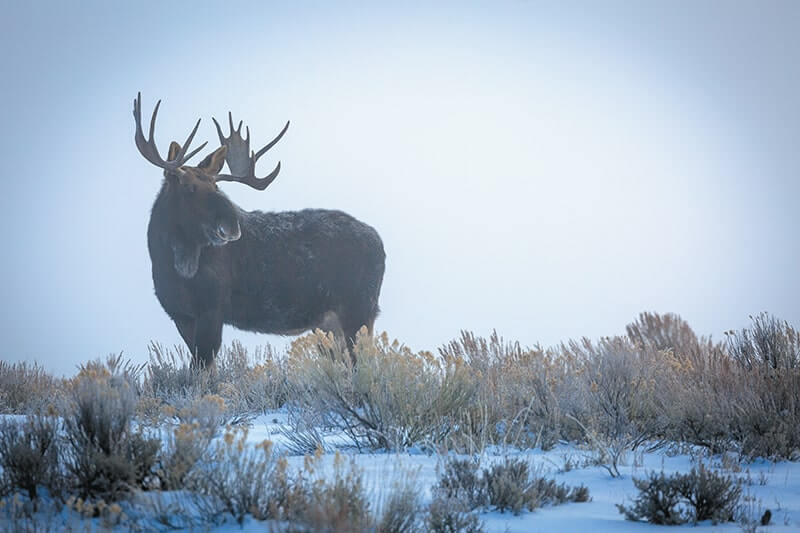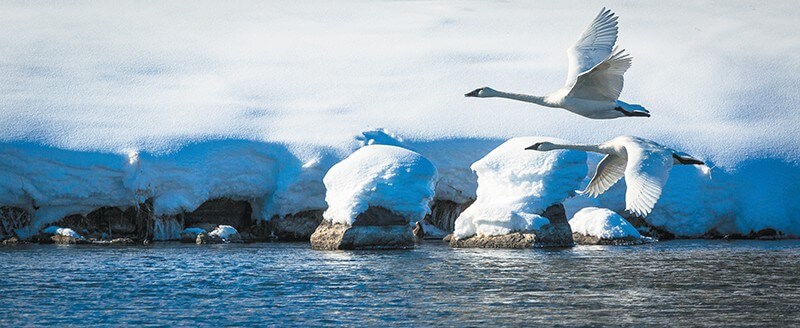Read The
Current Issue
Wonderland in Winter
You never know what wildlife you’ll meet when you get off the beaten path in the Greater Yellowstone Ecosystem in winter, but you’re almost guaranteed to see few (if any) other people.
By Brigid Mander // Photography by josh metten

The winter season provides stillness and solitude across the Greater Yellowstone Ecosystem.
IT DOESN’T TAKE us long to leave behind the colorful chaos of the town of Jackson and the crowds of Jackson Hole Mountain Resort. Barely twenty minutes have passed, and my boyfriend Andrew and I have seemingly entered another world altogether. We drive an empty road north toward Yellowstone National Park through rolling sage flats under a deep blanket of snow. We parallel the shadow of the Tetons. The landscape is silent, calm, and lonely—and what we are in search of.
We’ve come this way for a quick breather, to take a break from our adrenaline-filled world of downhill skiing and the increasing human pressure in the small valley that is Jackson Hole, and to appreciate some of the more subtle things that make this place so special. Our plan is to camp at Two Ocean Lake, in the northernmost part of Grand Teton National Park. The only way to get to the lake, which is hard-frozen and buried beneath feet of snow at this time of year, is to ski or snowshoe. Andrew and I will do the former. Our goals are to unwind, enjoy the landscape, and check in on our fellow creatures wintering in the harsh conditions of this beautiful place.
THE GREATER YELLOWSTONE Ecosystem (GYE) is between 16 and 22 million acres, with moving boundaries, because wild animals don’t recognize political or park map lines. The GYE includes Grand Teton and Yellowstone National Parks as well as six national forests, BLM lands, private and tribal lands, and municipalities, including the town of Jackson itself, which was built on traditional winter range for elk, deer, moose, and predators. It is one of the largest and most intact temperate-zone ecosystems on Earth and home to the largest concentration of wildlife in the Lower 48.
Winter in the ecosystem’s core provides an ethereal experience. Late winter—we visit in March—the area feels like some prehistoric, undiscovered world. On previous multi-day ski expeditions in nearby ranges I’ve seen wolverines, coyotes, ermines, and other small creatures. Andrew and I are not sure what animals we’ll cross paths with on this trip. Bison are likely and wolves a possibility, but bears are (hopefully) still sleeping, and elk, antelope, and deer for the most part are still at their lower elevation wintering grounds. We are pretty sure we won’t see any other humans.
On previous multi-day ski expeditions in nearby ranges I’ve seen wolverines, coyotes, ermines, and other small creatures.
Just a smattering of backcountry skiers are exploring the high Teton peaks to our south. Throughout winter, Yellowstone National Park’s 3,471 square miles are nearly devoid of people. That is close to the complete opposite of what this area will be in a mere four months. In July of 2018, the most recent year for which statistics are available, Yellowstone welcomed 947,000 visitors, and in June 2018, Grand Teton National Park (GTNP) hosted 627,000 visitors. March, on the other hand, is Yellowstone’s third quietest month, with an average of about 22,000 visitors. GTNP gets an average of about 50,000 visitors in March, most of whom are backcountry skiers.
ABOUT AN HOUR after leaving Jackson, Andrew and I are at the beginning of the road that in summer leads vehicles to the Two Ocean Lake Trailhead. In winter, though, this road is not plowed so the “trailhead” is at the highway. We park and click into the bindings of our Nordic skis and shoulder our backpacks, stuffed with sleeping bags and pads, our four-season tent, a light camp stove, extra layers, and food for two days. We begin skiing up a gentle snow-covered incline into the woods and enter a white silence. There is only the softly hushed glide of skis over snow, the compression of pole-basket pushes, and winter birdsong—clear notes floating through crisp air. The snow is pure white. The sky is grayish white. Even the green evergreen boughs are camouflaged by loads of white snow.
Every now and then, a bird perches in a branch near us, inspecting us ground-bound interlopers. Andrew identifies these—ruffed grouse, hairy woodpeckers, black-capped chickadees—and more. A golden eagle circles overhead before banking off towards where Pacific Creek flows into the Snake River. (Although Two Ocean Lake is frozen, moving water is not.) An echoing call comes from across the snowy marshlands, and we determine it’s a trumpeter swan, wintering here from its summer home in the Canadian taiga, where winters are even harsher than in Wyoming. Many swans winter near Jackson, and some continue farther south to Utah and parts of eastern Idaho. During the spring and fall migrations, observant watchers may even see tundra swans stopping over on their travels between California and northern Canada.
We glide rhythmically through the woods, a chilly breeze rippling through the trees every few minutes. Taking our time, we investigate stumps that woodpeckers have latticed, marvel at the different types of evergreens (grand firs, lodgepole pines, spruce), and aspens. We peer up close at “rubs,” the marks made on trees when, in late summer, bull elk and mule deer scrape their antlers to remove the velvet and/or to assert their presence to others of their species. We even see a few recent elk tracks heading south, no doubt the leading edge of the spring migration.
Reaching the top of a rise, we look down its gently sloping backside to a wide-open, flat snowy expanse where red willow stalks contrast starkly against the snow. A young bull moose moves through the snow, browsing for food along the wetland corridor. A pair of sandhill cranes, newly arrived from their winter home, perhaps as far south as New Mexico, delicately pick through some brush on long stick legs. Their rattling calls are exotic. Through binoculars we watch as they begin their mating dance: wings spread, they jump up and down in circles around each other and dramatically bob their heads. I’ve never witnessed this storied behavior, which I find completely riveting. We watch the pair for 15 minutes and would have watched longer had they not hopped and bobbed their way out of sight.
Moving on, we do not talk much. We soak up the silence and the occasional golden rays of sunshine that slice through the cloud cover. Stopping as frequently as we do, it takes us two hours to ski the three miles to Two Ocean Lake, now merely a placid, white expanse. Beyond it, the Tetons rise above pine forests. We ski around the lake as slowly as we approached, and after a mile or so pitch our tent in a protected pine grove a little back from the shore, in case any wind arises.
We fall asleep under a vast sky to a soundtrack of mysterious screeches and calls. We’re not that isolated—our car is barely five miles away—but we feel as if we’re days from the nearest road. Tomorrow, we’ll wake up for hot coffee and a whole new adventure with the area’s wildlife. Whether we see a lot or a few, birds or busy coyotes, we already feel revitalized—and most of all, lucky to be a part of this place, if only for a short time. JH
NUTS AND BOLTS
A permit is required for any overnight backcountry camping in Grand Teton and Yellowstone National Parks; secure one by calling 307/739-3309 (Grand Teton) or 307/344-2160 (Yellowstone). If you choose to camp in the nearby Bridger-Teton National Forest, permits are not required. Various wildlife tour operators including Jackson Hole Eco Tour Adventures offer group and private guided winter wildlife outings in the Greater Yellowstone Ecosystem. Some customizable, multi-day options on skis or snowshoes include lodging in Yellowstone National Park at Old Faithful Inn or basing out of Gardiner, Montana. jhecotouradventures.com

Beginning in late summer and early fall, moose can be seen at the lower elevations of the valley.

Many trumpeter swans winter in and around Jackson Hole; some of these birds spend summers in the Canadian taiga.




